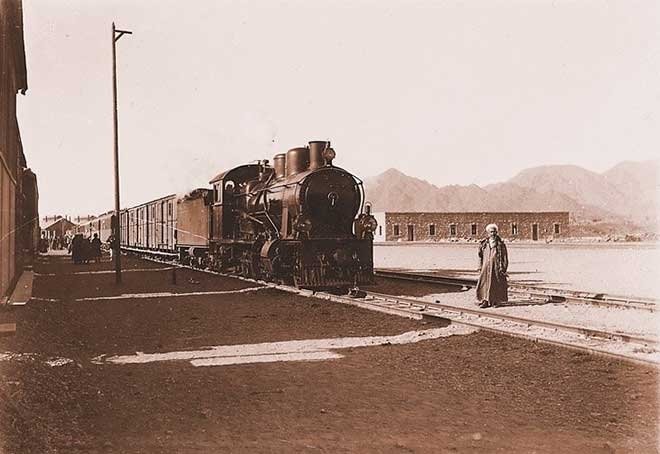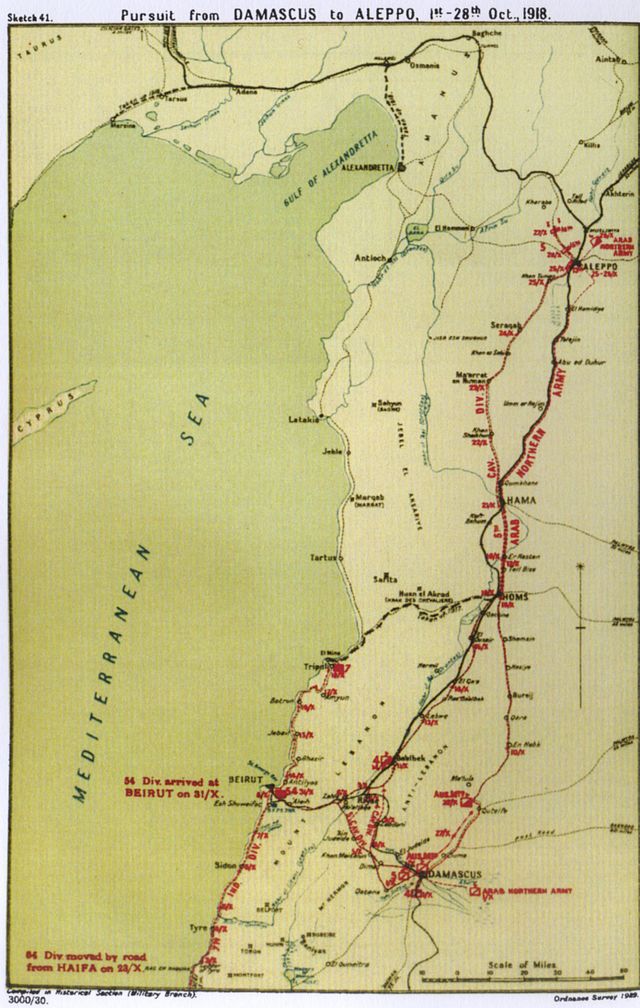Army's retreat from Palestine, Major Vecihi describes the
fall of Damascus on 1 October 1918 and the capture of
many Ottoman soldiers. He may have been one of them
since his cavalry unit was captured, although he doesn't
explicitly say so.
It is worth remembering that as the Ottoman Army fled
from Palestine in defeat, at the same time, a thousand or
so miles away in Dagestan, the Ottoman 'Islamic Army of
the Caucasus' was scoring one of the Ottomans' few
victories in The Great War. That victory, though, was
essentially erased by the Ottoman surrender at Mondros
on Limnos Island in the Aegean Sea on 30 October 1918.
Victory in Dagestan click here for the final segment of an
11-part TNT series from 2018.//

Our cavalry division, after 11 days of serving as rearguard and the flank
guard for the army in the battles in the Şeria (Jordan) River valleys and
in the deserts of Havran, found itself again serving as the army's rear
guard on the approach to Damascus, being asked to perform duties
beyond its remaining strength and endurance, but doing so with faith
and determination.
The cavalry was on the alert for an order to retreat that never came so,
in the end, 26 officers and 85 soldiers were taken prisoner, but without
casting shame on their military professionalism. As fate would have it,
just as the cavalry division was being taken prisoner, an officer bearing
an order from the commander of the 3rd Army "to pull back" arrived
but he was captured by two Indian soldiers.
The night before, the cavalry's health unit, heavy equipment, animals
and artillery team has been sent on to Damascus, lightening the
division's make-up considerably. And because these elements left
Damascus the next morning, before the city fell to the enemy, they
did not suffer the dismal fate of the remaining elements of the division.
Damascus fell on 20 September 334 (1 October 1918, based on today's
calender). A composite detachment was sent to defend against the
advancing enemy near Semse but its commander, Rikabizade Ali Rıza
Paşa, went over to the British side and the road to Damascus was left
open. The order was given to flee the city but it was too late.

The Germans, who had control of the railroad, made every effort to
get themselves and their belongings out. The army's most valuable
items were loaded on a train around noon and it departed, but only
with great difficulty. However, at a pass near Demer the train came
under enemy machine gun fire. When it was realized that the train
could not proceed in its original formation, the wagons in which the
Turks and the Turkish Army's goods were riding were decoupled
and the train slipped away, comprised of only a few wagons.
It was a frightful sight, as you can imagine, with the bodies of
unarmed people lying around on roads and in ditches. Surviving
troops, officers, along with screaming women and children, tried to
make their way back to the city, as they were mugged by
opportunistic Arabs. Other Arabs took advantage of the situation to
celebrate 'Independence' in the streets of Damascus.

Those Turks who fled the city in the morning were the exceptions, as
those who left later were all captured. That same day one of the two
roads that leave Damascus to the north was occupied by the enemy at
Rebva pass and the Duma road was taken, as well. Those who had
come to Damascus after slipping away from the ongoing battles at
Artoz and Kiswa were taken prisoner in the city, while those on the
Nabak road were captured near Duma.
The entire 53rd Division, which retreated from Cebel-i Esud in the
afternoon, was captured the evening of the same day near Duma.
The 48th Division of the 4th Army reached Kiswa in the evening on
30 September but, upon encountering the enemy, headed east into the
desert for the night. Early the next morning, the 48th Division thought
about entering Damascus but the enemy's presence there made them
head instead toward Duma, where despite their best efforts, they
suffered the same fate as the 53rd Division.

British pursuit of the Ottoman Army from
Damascus to Aleppo.
Even those who fled Damascus in the morning and most of those
who escaped over mountain roads were subsequently taken prisoner
at Homs, Hamah and Aleppo. In truth, the reason for their capture
was the Arabs who informed on them, more than the pursuing
enemy's operations. The Arabs would promise the fleeing Turks
safe harbor and then turn them over to the enemy after getting paid
to do so.
The British claimed to have taken 100,000 prisoners in the aftermath
of the fall of Damascus but I doubt it. In any case, half of their
prisoners were soldiers at the way-stations, Ottoman officials and
students.
The desperate situation at Damascus was clear from the start, there
being no real hope of defending the city. If this had been recognized,
a 50,000-strong army could have been assembled around Aleppo.
Unfortunately, when this was not done in a timely manner the cost to
us was quite high. So, this was the final, painful consequence of the
inauspicious actions and activities of the 5-year German Military
Mission in Turkey led by Liman von Sanders!
//END of PART XV/FINAL//

Hiç yorum yok:
Yorum Gönder